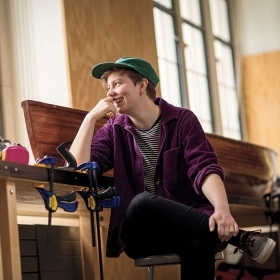I learn a lot about my neighbors on my early-morning walks: who leaves for the gym at zero-dark-thirty, which kids are fond of street hockey, whose puppy thinks my down jacket is a blue monster from hell. Last fall, I also got a pretty good idea about the political views of my neighbors, thanks to a plethora of campaign lawn signs.

Illustration by Alex Nabaum c/o theispot.com ©2017
Yesterday, I bought yet another pair of running shoes. I had literally walked the soles off my previous pair, something, to my astonishment, I manage to accomplish every few months. I’m a reformed couch potato and now am out walking in my neighborhood in all weather—at dawn or after work, daylight or no.
I learn a lot about my neighbors this way: who leaves for the gym at zero-dark-thirty, which kids are fond of street hockey, whose puppy thinks my down jacket is a blue monster from hell. (Thanks for the early-morning salutations, Finn. Love you anyway.) Last fall, I also got a pretty good idea about the political views of my neighbors, thanks to a plethora of campaign lawn signs.
The political leanings of our state and my town are no secret, and the signs pretty much fell in line. Except for one house two blocks over that proclaimed strong support for a candidate of another stripe. I noticed the boldly lettered sign stuck on the yard’s picket fence one night after work. But by early the next morning, it was gone. That evening, a replacement was up. The following morning, it had disappeared again.
This happened over, and over, and over in the run-up to election day. No amount of duct tape could keep that sign in place on the fence. It actually made me sad. I suspect political views on both sides got more entrenched as the sign incidents multiplied. What would have happened instead if a little conversation—even just, “Hi, how ya doing?”—had taken place between neighbors across the top of that fence? No one has to agree, but knowing even a little about the person on the other side of the pickets can go a long way.
I got to thinking about this as I edited two of our features: “Having Faith in America” by Amita Parashar Kelly ’06 and “The Opposite of Difficult” by Kate Erickson ’05.
While researching her profile on Farhana Khera ’91—executive director of the nonprofit Muslim Advocates—Amita attended a community meeting where Boston-area Muslims voiced concerns about their children being bullied in schools and the increased possibility of hate crimes. But instead of turning inward, they focused on how they could reach out to their neighbors and promote understanding. “We need to take risks and begin dialogues,” says Tasneem Dahod Dohadwala ’04, who organized the meeting. “So much of this angst comes from people being in fear, so it’s our responsibility to work to assuage those fears. We, Muslims, are only here to embark on the grand American dream just like everyone else.”
In “The Opposite of Difficult,” we hear how Wellesley alumnae from around the world put out a neighborly hand to the family of Syrian refuges who moved in next door to Kate. The family, who had come from Aleppo after their young son was gravely wounded by a sniper, had no English and needed help. Kate found Arabic-speaking alums who translated via Skype from Jordan. Others sent care packages, and Kate herself offered all manner of assistance. In return, Kate found something she had been searching for since her childhood.
If you need a quick break from the polarization that seems to be all around us these days, look at these pieces. When you’re finished, might I suggest putting on a pair of comfy shoes and going out for a walk through your neighborhood? You don’t have to wear the soles off. Even a few steps can go a long way.


